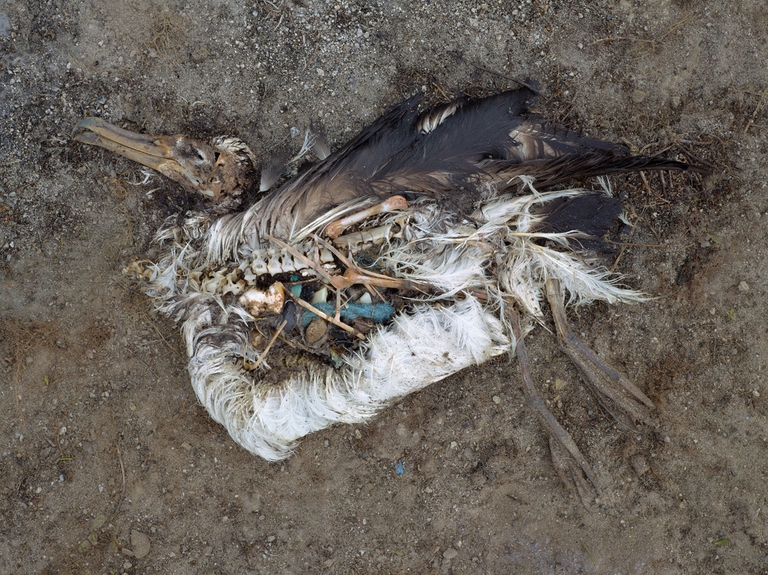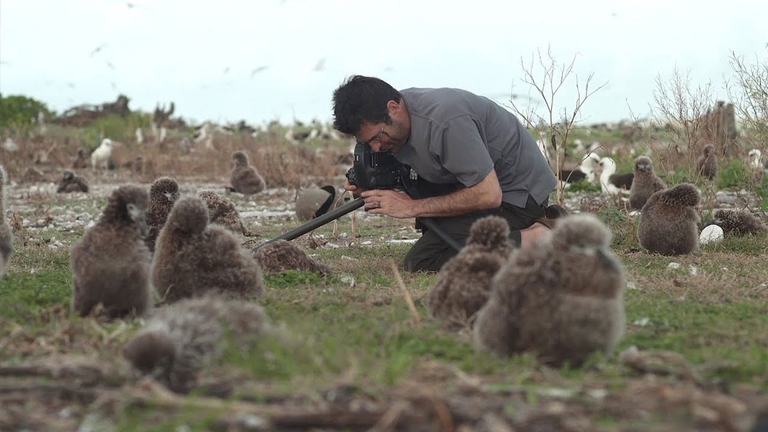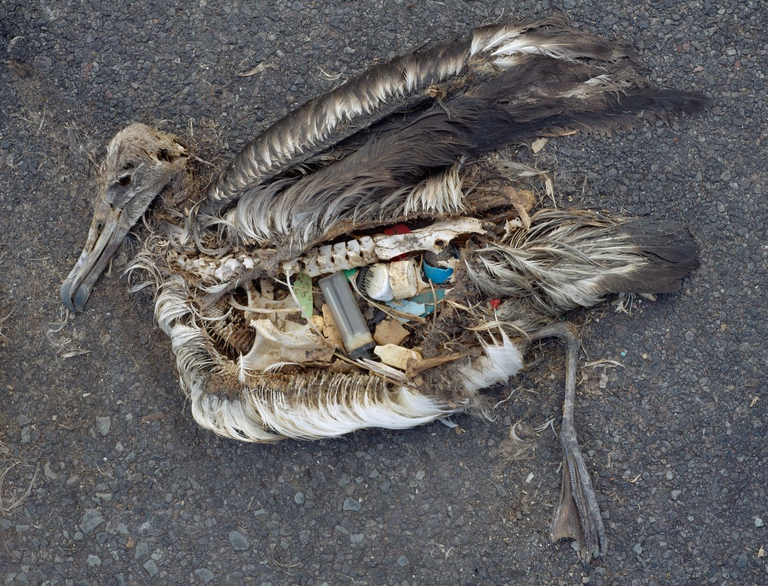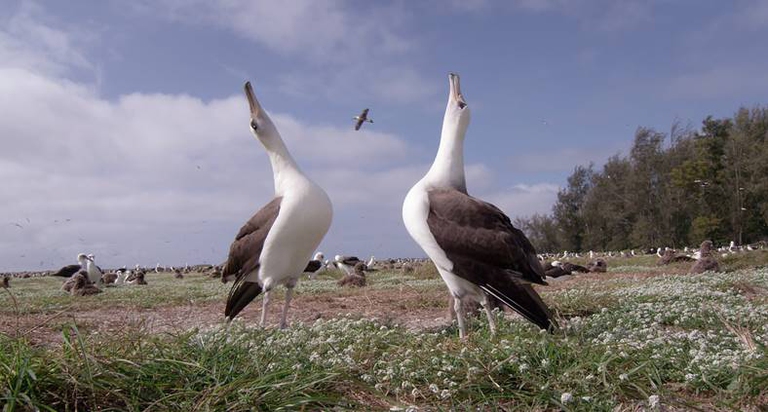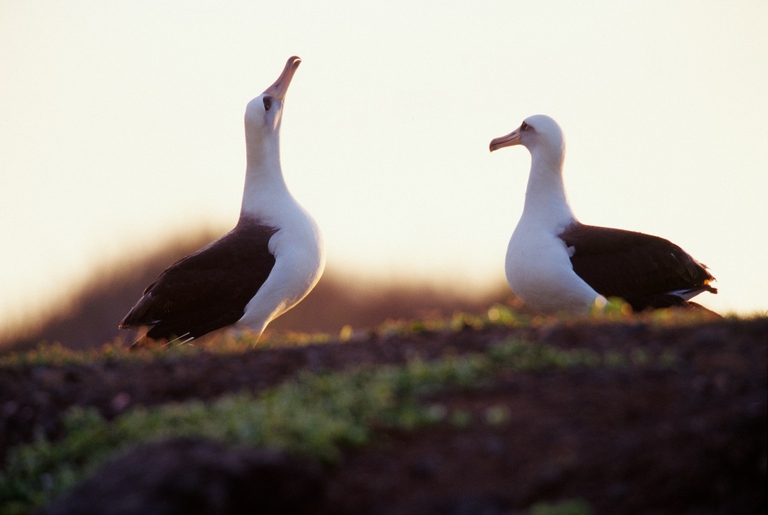
A group of experts in Tokyo suggested pouring radioactive water from Fukushima into the open sea. A marine biochemist explains the consequences of this absurd decision.
Basta una manciata di plastica nello stomaco di un uccello per capire l’immensità del problema della plastica. E risvegliare le nostre coscienze. L’intervista al fotografo Chris Jordan, autore del documentario Albatross.
To better understand the effects plastic has on marine ecosystems, scientists started using the state of health of seabirds as indicator of the extent of plastic pollution. They found out that 9 in 10 seabirds have plastic debris in their stomach. This means that plastic has already reached any corner of the Planet. 300 million tonnes of plastic become waste every year, of which 8 million tonnes end up in the world’s seas. Considering that each piece of plastic ever created still exists today, it is estimated that hundreds of millions of tonnes of plastic have already piled up in the oceans’ depths over the years. These ever more accurate, and frightening, data makes us realise the hugeness of the problem we’re now facing.
Plastic is affecting even the remotest places on Earth, on which humans usually don’t set foot. The Planet’s remotest island, 2,000 miles away from any continent, has become the symbol of our consumerist lifestyle and, by consequence, of the huge problem that is chocking our oceans. The island is called Midway and is located in the middle of the Pacific Ocean. The island was once used as an aerial and naval base by the United States and is now sometimes used by NASA for emergency landings. Since 2006, it is part of the Papahānaumokuākea national monument.
American photographer Chris Jordan visited Midway almost ten years ago and, once there, he was immersed into the natural beauty of the place which was however ruined by the plight of plastic. The testimonies, and victims, of it are the only inhabitants of the island: albatrosses. After taking a series of photographs that have become iconic, Jordan returned to the island to make a documentary, Albatross, to move people’s consciences. The documentary can be streamed online and has been screened at the United Nations in occasion of World Oceans Day celebrated on 8 June. We talk to Chris about his experience, his work and his vision on possible solutions to this problem.
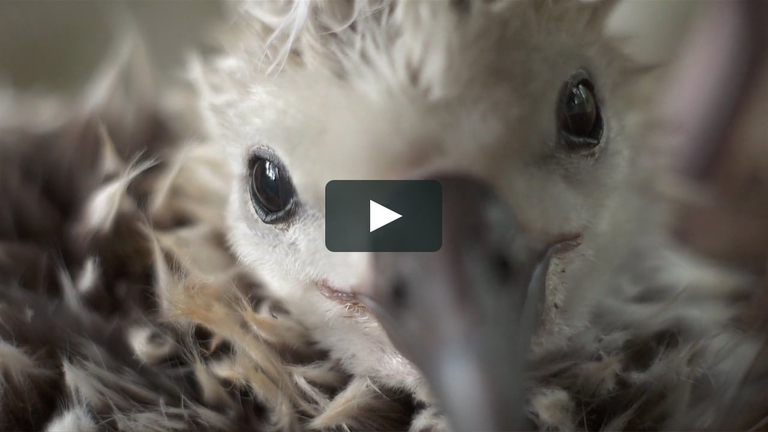
How have you come to realise that that of plastic was your battle?
I’ve been interested in mass consumption for about twenty years now. It has been the primary subject of my work. So I’ve been doing different kinds of work to look at the phenomena that relate to mass consumption – whether it’s the number of cars and computers we buy or the prescriptions of painkillers we take. As part of that work I’m always looking into more and more issues around mass consumption. It was 2008 when I first heard about plastic in the ocean and became fascinated by this topic.
You visited Midway for the first time back in 2009. Why did you decide to go precisely there and what did you see and experience?
I heard from a friend who had been there about this incredible powerful tragedy that functions as a symbol for the whole world. On this incredibly remote island in the every middle of the Pacific Ocean are tens of thousands of dead birds on the ground whose bodies are filled with plastic. When I went to Midway the first time I realised that all of my work around mass consumption was always looking at this global issue from a global perspective. So I wanted to look at the issue of ocean plastic from a more personal point of view. And when you see these little handfuls of plastic inside the birds you don’t need to see the whole millions of tonnes. Just one handful of plastic inside the bird tells the whole story.
Almost all sea birds in the world have plastic in their stomach, why did you decide to focus on albatrosses?
At that time there was very little science being done about plastic inside birds. There was also something so symbolic about what’s being happening on Midway. The fact that it’s such a remote island in the very middle of the Pacific adds some meaning to it. If there was an island two miles off the coast of New York that had birds filled with plastic, It would be a very different thing. Also, of all of the birds that can be sending us this message about our broken relation with the living world, the albratross has a long history in our poetry and literature as a carrier of messages and one of the most legendary birds. I really love that. Even from the first time I went to Midway I immediately had a very strong feeling of being like inside a poem, with all of these layers of metaphors and symbolism.
Albatross has been screened on World Oceans Day 2018 at the United Nations. What do you expect from institutions on the issue of ocean plastic?
To me some of the most interesting activism right now is happening inside institutions, companies and organisations that support the cause. One of these is Parley for the Oceans, which is doing a lot of work inside companies to help them change their business paradigms around plastic. It is also in charge of the World Oceans Day programme at the United Nations. They’re building a network of companies, people, governments and entities of all kinds for transformational change. I think this is pretty exciting.
On the other hand, can we as individuals really make a difference in ending the plight of plastic pollution?
To me this issue is part of the broken paradigm of environmental activism. There’s so much environmental activism where people tell other people how to behave. And it’s almost always about little things like “take shorter showers”. If everybody in the whole world did this it wouldn’t make barely any difference. I think we have to overcome the idea that each of us can save the world by making little gestures because we know that there’s something about that that isn’t true. We have to feel our dissatisfaction with the scale of the solutions. The solutions have to be on the scale of the problems. An example are documentary films that often show a catastrophic global disaster and then they give you a list of five things you can do like “pump up your car tires to their full pressure so you can have the best gas mileage when you go on a road trip” or “don’t order a straw when you go to a bar”. This is like telling somebody that it’s all they can and should do. It’s like disempowerment. I think we all know we are more powerful in groups, communities and nations than we are as individuals. And if we can make a shift in consciousness we can begin to choose better leaders and really start to make changes that are on the scale of the problems.
According to you, Albatross is different from traditional documentary films. How?
There are many ways in which Albatross breaks the rules of documentary filmmaking. I’ve talked with lots of filmmakers when I started making Albatross because I wasn’t a filmmaker. One of the things that a lot of them told me is that I had to make a tight rhythm. It has to be fast as everybody has a really short attention span, so you have to make your point and move on. But I’ve never felt that way. Imagine if I can bring you on Midway Island. We would walk to the nest of baby albatrosses and we could squat all the way down and put our face right where the albatross hatch. We would sit there on our elbows for hours until our back is sore just to watch how beautiful it is.
Read also: 8 June is World Oceans Day 2018, a global call to stop plastic pollution
Another thing that I spent a lot of time thinking about is that many documentary films present the world only from a factual-scientific and observational perspective. When I was on Midway, the experience I had was just tremendous beauty everywhere. Midway is an unbelievably beautiful place and albatross are incredibly beautiful creatures. So I had to include that beauty as a way of documenting the reality of the island. Being on this island with several millions of birds that have no fear of humans made me feel like beng in paradise. And because they’re filled with plastic, it was also like being in hell at the same time. I wanted to bring all of those elements in as part of the documentary artform. Also, there isn’t much narration, but a lot of beautiful music. There are 19 pieces of music played at their full length. Albatross is an immersion into beauty, sadness and grief.
What kind of impact do you think this documentary will have on people?
I shaped it like a sort of guided meditation. At the beginning of these ceremonies you usually have to face your fears and something really scary happens. This is how it starts: facing the horror of plastic. We start with horror and fear, but when aren’t scared anymore then we open up to curiosity and learning. There’s a scene that I specifically talk about fear as birds have no fear of us. Then there’s a scene of curiosity as birds come towards the camera and look right into it in such an amazing way. In the presence of curiosity we get the encounter of others and we experience empathy. Empathy and curiosity are the beginning of connection. And connection is the beginning of love. As we fall in love with the birds we also see in multiple ways that they’re filled with plastic and begin to experience grief. That’s the core of the film – the understanding and experience of grief. Grief is not a bad feeling. It’s not the same of despair. It’s a sort triangle: it’s beauty, sadness and love, all mixed together. It’s incredibly vivid, it’s the experience of being alive and so it’s electrically powerful. It’s almost an ecstatic experience that connects you deeply with life.
On Midway there has been one amazing change that happened: the population of albatrosses went up by 500,000 birds. This is an important point of the story. They aren’t going extinct because of plastic, but this doesn’t make their suffering any less tragic or sad. But this gives us an opportunity. Take the elephants in Africa. They can’t be a metaphor for the world. The only conversation about elephants in Africa is “we have to save them”. But we can look at the story of albatrosses as a metaphor, like a reflection of our own culture.
What Albratross is really about is shifting consciousness and this is the attention behind the film and project. By shifting consciousness I mean reconnecting more deeply with our love for the living world. That’s really my whish. I want to spread Albatross as far as possible as it’s a love story, a love offering on behalf of all life, not only albatrosses.
Siamo anche su WhatsApp. Segui il canale ufficiale LifeGate per restare aggiornata, aggiornato sulle ultime notizie e sulle nostre attività.
![]()
Quest'opera è distribuita con Licenza Creative Commons Attribuzione - Non commerciale - Non opere derivate 4.0 Internazionale.
A group of experts in Tokyo suggested pouring radioactive water from Fukushima into the open sea. A marine biochemist explains the consequences of this absurd decision.
The decline in grey and humpback whales in the Pacific and Atlantic Oceans has been traced to food shortages caused by rising ocean temperatures.
The United Nations has launched a major international alliance for ocean science, undertaking a mission close to all our hearts.
The cargo ship that ran aground off the coast of Mauritius on 25 July, causing incalculable damage, has split in two and its captain has been arrested.
The largest coral reef in the world is severely threatened by climate change, but researchers are developing strategies that could contribute to saving the Great Barrier Reef.
Seychelles have extended its marine protected area, which now covers over 400,000 square kilometres, an area larger than Germany.
Norwegian oil giant Equinor had pulled out of drilling for oil in the Great Australian Bight, one of the country’s most uncontaminated areas. A victory for activists and surfers who are now campaigning for the area to be protected forever.
30 per cent of the planet needs to be protected to stop precipitous species decline. The UN has set out its aims for the the COP15 on biodiversity scheduled for Kunming, China in October.
Ocean warming has risen to record highs over the last five years: just in 2019 the heat released into the world’s oceans was equivalent to that of 5-6 atomic bombs per second. The culprit, no doubt, is climate change.
